On July 14th, 2021, we listed the Global X AgTech & Food Innovation ETF (KROP) on Nasdaq. KROP is designed to provide exposure to companies that are positioned to benefit from further advances in the fields of agricultural technology (“AgTech”) and Food Innovation.
AgTech and Food Innovation are playing central roles in facilitating the shift to more sustainable production and consumption patterns.
For many consumers, price hikes in the produce aisle and sold out toilet paper are the fullest extent of stressed supply chains. Inputs, in-between processes, and outputs can seem segmented and distant. For others though, the connection between production and consumption is palpable, especially as it concerns agriculture and food. This often manifests as food insecurity – 746M people, or 16% of the global population, have at one point lacked access to sufficient food.1 It is also felt through lost livelihoods as extreme climates cause crops to wither and farm incomes to dwindle, partially due to the very practices that once made them flourish. Fortunately, AgTech and Food Innovation offer solutions that can bridge production and consumption gaps, while also reducing externalities like climate change and environmental degradation.
In the following piece, we explore how AgTech and Food Innovation can help solve for both sides of the sustainable production and consumption equation.
Key Takeaways
- Disruptive technologies and cultivation methods like those involved in precision agriculture, agricultural robotics & automation, controlled environment agriculture, and agricultural biotechnology can increase agricultural productivity and sustainability
- Food Innovations like dairy and protein alternatives and food waste reduction technologies could drive a shift in agricultural practices, reduce the sector’s negative externalities, and help mitigate food insecurity
AgTech: Using Technology to Positively Impact People, the Planet, & Profitability
Modern agriculture encompasses multiple systems that are tied together by the common thread of plant and livestock cultivation. Of primary importance are agroecosystems, or environments modified “to produce food, fiber, and other products for human consumption and processing,” and food systems, which overlap with agroecosystems but also include product distribution and food consumption.2,3 It is within these systems where disruptive innovation can affect meaningful change toward more sustainable production and consumption. In this section, we investigate AgTech’s important role in this transition.
Improving Efficiency with Precision Agriculture
Myriad variables affect crop yields and quality across fields and between harvests. Crops grown on one field may require fertilizers, pesticides, or other inputs that may not be necessary for those grown on another. Traditional agricultural practices struggle to keep track of and adjust for these variables, potentially leading to inefficient resource-use and sub-optimal yields. This is where precision agriculture comes in.
Precision agriculture seeks to maximize crop yields and quality while conserving inputs like water, fertilizer, pesticides, and labor. Key to this are the Internet of Things (IoT) and Artificial Intelligence (AI). With these technologies, farmers can monitor and address the precise needs of specific crops and livestock. This concept is known as variable rate application (VRA).4 How does it work? Connected sensors record and transmit data on soil moisture/nutrient levels, soil acidity, water absorption, plant/livestock health, weather, and more.5 Artificial intelligence then uses this information, coupled with GPS data, to generate precise instructions for farmers or agricultural robots. Seen in practice:
- A farmer’s John Deere See & Spray machine uses its RGB camera to scope and transmit data on its surroundings. AI-enabled software processes data from the camera and differentiates crops from weeds. It then generates instructions for the machine to only spray the weeds, potentially reducing herbicide use by 77%.6
- A farmer employs a satellite imaging service to frequently capture images of their farm. AI processes these images and identifies that crops on one field are smaller and less green than similar crops on another. The farmer uses this information in tandem with soil data to determine the best course of action for the crops in question.
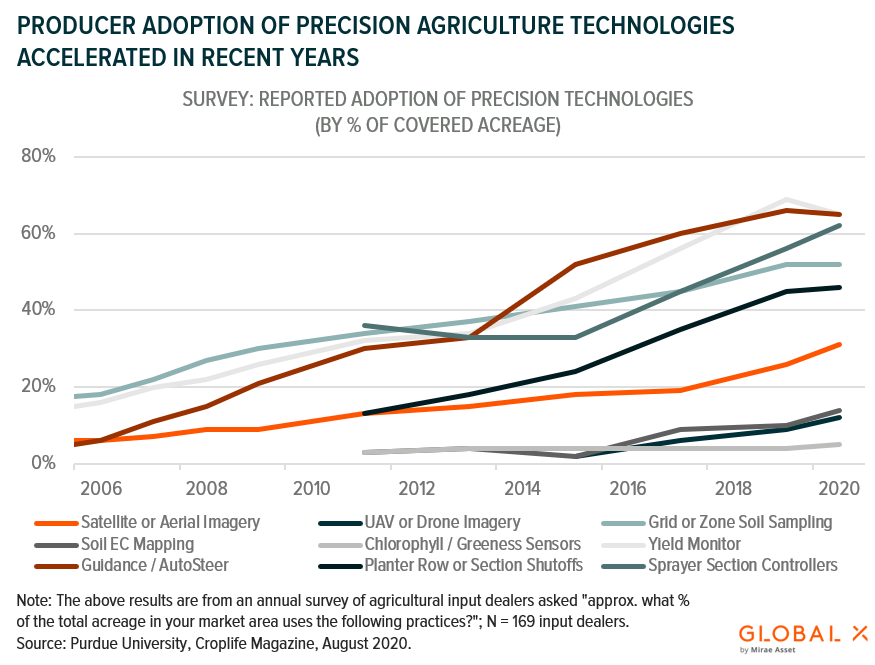
This level of precision is necessary for a growing global population that needs to be fed. Demand for agricultural products is increasing, some estimate by as much as 50% between 2012 and 2050, and it is all too easy to underestimate the resource intensity and negative environmental impacts of traditional agriculture practices.7 Agricultural systems occupy 43% of the world’s ice- and desert-free land and are responsible for almost 2/3 of all global freshwater withdrawals and 18.4% of greenhouse gas emissions.8,9
All the while, a meaningful share of crops never leave the farm – it is estimated that 16% of U.S. food waste by weight, representing $15B of product, happens on farms.10 Much of this can be attributed to crops lost to disease, pests, and other factors, though unharvested or disposed-of excess crops are also to blame. Many farmers overplant their fields to compensate for losses and/or to meet unanticipated demand, but then destroy excess crops as it is the most affordable option.11 Precision agriculture represents a possible solution to these inefficiencies, eliminating wasteful guesswork and optimizing agricultural inputs and outputs.
The global market for precision agriculture is expected to grow from $5.3B in 2020 to $10.7B in 2026, representing a 12.3% compound annual growth rate (CAGR).12 We expect that increasing demand for agricultural products and a dire need for more sustainable production methods will drive this growth in the long-term as stakeholders strive to minimize inefficiencies and negative externalities. Precision agriculture-driven revenues and long-term cost savings potential will likely incentive adoption among producers, especially as economies of scale drive down upfront costs and technological advances introduce new capabilities. Consumer and industrial IoT adoption and the rollout of 5G networks represent inter-sector tailwinds to these ends.
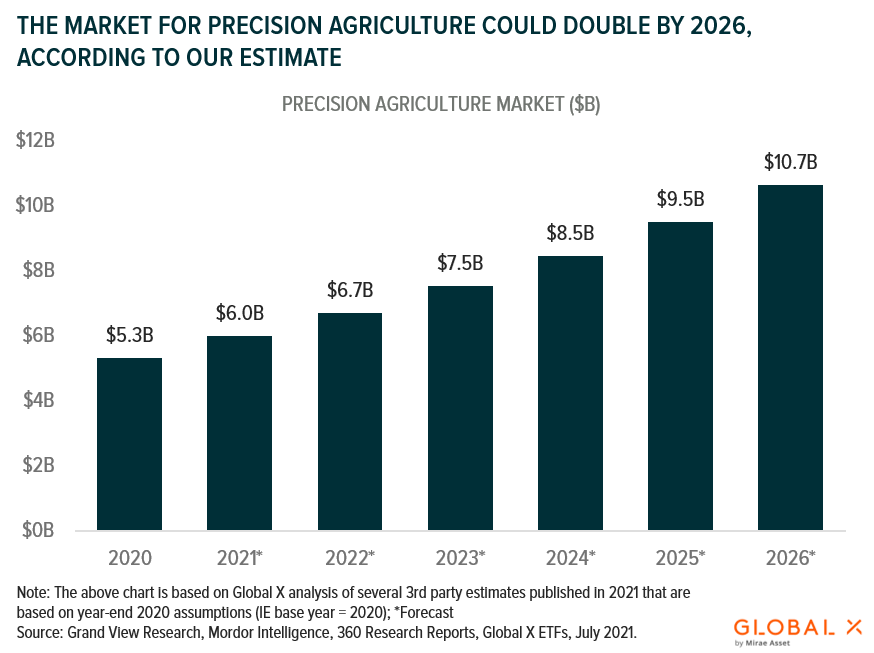
Employing Robotics & Automation in Agricultural Settings
The traditional image of agricultural work is one of difficult manual labor. Today though, this depiction is fading into antiquity. The recent proliferation of robots and automated processes on farms means that farmers are increasingly tending to their fields from behind control panels. By design, these technologies increase agricultural labor productivity and help to conserve agricultural inputs, especially when implemented alongside precision agriculture technologies.
Agricultural robots come in many shapes and have diverse applications. Robots used in crop cultivation, for example, often come in the form of self-driving tractors and autonomous farming tools, which are either built into such vehicles or dragged behind them (whether the tractor is autonomous, or not). These robots use vision sensors, AI, and GPS data to autonomously navigate and complete tasks as directed by precision agriculture systems and/or producers. Typical tasks include tilling, mowing, hauling, and crop monitoring, though some robots feature specialized arms and grippers that allow them to prune and harvest crops. Harvest CROO, a Florida-based startup invested in by over 70% of the U.S. strawberry industry, developed a strawberry picking robot that uses vision sensors and AI to identify ripe berries and its 96 picking claws to harvest them.13 Agricultural unmanned aerial vehicles (UAVs) or drones, can also assist in cultivation. UAVs navigate the sky autonomously and producers most commonly use them for planting seeds, spraying weeds with herbicide, and monitoring crops from above.
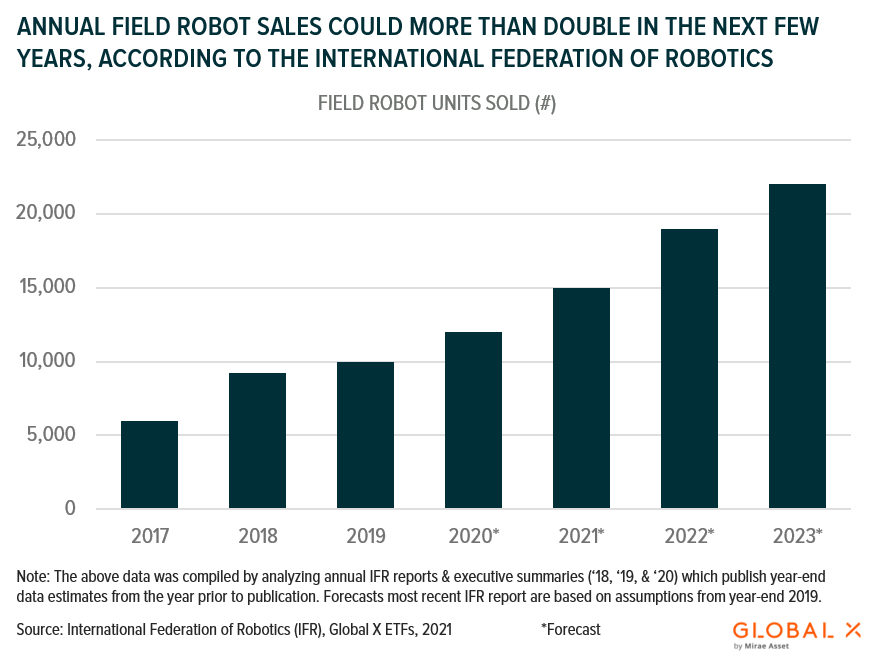
Cultivation robots are still in the earlier stages of adoption, but producers are rapidly turning to them as they become more affordable and technological advances improve their abilities. We expect this to continue as global agricultural labor shortages and aging populations drive adoption and economies of scale. Synergies with precision agriculture will likely drive further demand as producers look to optimize their operations from end-to-end. Further, the sector has a history of successfully adopting automation technologies – dairy robots were introduced over 25 years ago and are still seeing increased use today. With these drivers in mind, the market for agricultural robots could reach $21.1B by 2026, according to some forecasts, up from $5.4B in 2020 and representing a 25.5% compound annual growth rate (CAGR).14
Cultivating Crops in Controlled Environments
Controlled environment agriculture (CEA), also known as indoor farming, is quite literally changing the playing field for agriculture. CEA is defined as the cultivation of plants and their products within controlled environment structures. These structures include vertical farms, which are indoor farms featuring vertically arranged stacks of crops; container farms, which are indoor farms housed in shipping containers; greenhouses; and micro-farms.15 As a sub-theme of AgTech, CEA includes technologies and systems that seek to optimize plant or fish-farming within controlled environments and reduce the need for and use of farming inputs.
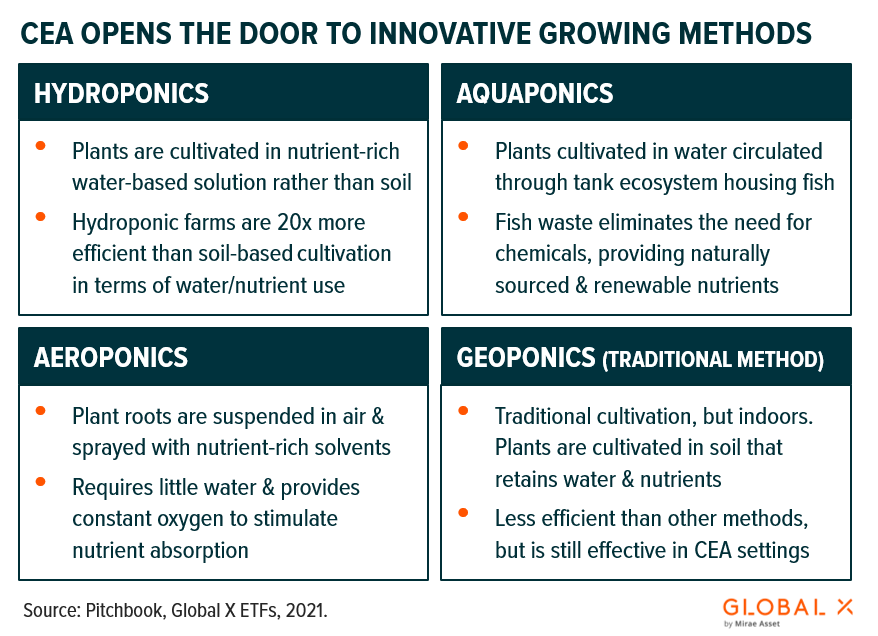
CEA challenges the notion that agriculture can only happen where the soil or weather is just right. With CEA, producers can grow quality food almost anywhere, from warehouses in inhospitable climates to urban basements. This can potentially boost local economies and minimize the waste and negative environmental impacts usually attributed to transportation, excessive packaging and preservatives. But most importantly, it makes feeding a growing global population more achievable. As discussed, a large share of the world’s ice- and desert-free land is used for agriculture – we are running out space and CEA presents an immediate solution to slowing this trend.16
CEA methods can also help reduce agricultures’ role in the global water crisis. Current cultivation methods are extremely water intensive, as mentioned. Vertical farming presents an immediate solution, requiring 95% less water than traditional agricultural methods.17 This is by design. The stacked and closed loop nature of a vertical farm means that water is constantly being recycled and any excess water is simply consumed by other plants rather than becoming run-off. And since vertical farming happens indoors, there is little to no need for pesticides and herbicides. Pesticides and agricultural chemicals are the fifth most water-intensive industrial sub-sector in the U.S., using roughly 30 gallons of water per dollar of output.18
Though the global CEA market is young and outdoor agriculture still produces the lion’s share of plant-based products, we expect CEA to gain significant market share in the coming decade. Why? The sustainability and potentially beneficial economics of CEA go hand-in-hand. In the long-term, CEA could improve producer’s bottom lines. Fewer inputs, more space to grow, and fewer intermediaries should translate to reduced costs. And on the revenue side, CEA-practicing producers could benefit from year-round production, more crop turns, increased product shelf-life, fewer recalls, and greater nutrition (which could offer a revenue premium).19
While the long-term prospects seem bright, CEA must first overcome several obstacles, including facility costs, limited product catalogs, and inconsistent production. We are encouraged by increased investment in the space, however, and anticipate that new funding will help vault CEA over these hurdles. In 2020, venture capital CEA funding totaled $929M, which is over 2x the amount raised in 2019.20
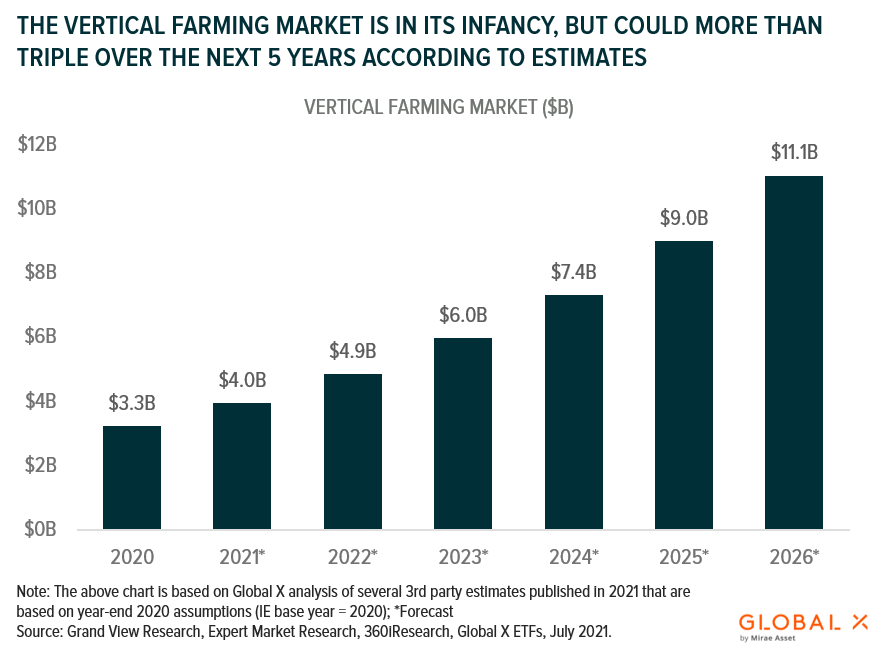
Using Biotechnology to Enhance Agricultural Processes
Recent advances in biotechnology also show promise for enhancing agricultural practices. Of particular note is agricultural genomics, which is best defined as using information from an organism’s genome, or complete set of genetic information, to improve the productivity and sustainability of crop and livestock production.21 Over the past two decades, the cost of genome sequencing dropped exponentially, enabling today’s regular and large-scale sequencing efforts and applications. In the healthcare sector, providers and pharmaceutical companies use genomic data to treat patients and fight disease with precision. Gene editing, for example, relies on information gathered from sequencing to target and edit specific sections of one’s genome that cause disease.
The agricultural applications are very similar. For one, genomic sequencing enables more purposeful and precise plant breeding for producers looking to pass on traits related to water, nutrient, and light requirements, as well as those affecting crop yield and resilience to disease. Producers can use genomic sequencing to identify which genes and/or combination of genes are most ideal for their purposes and breed their crops accordingly. Or, producers can apply the same gene editing techniques used in healthcare to create and mass-produce designer crops that have optimal characteristics for cultivation and use. These practices are already being successfully employed by researchers. Notable results include gene editing rice to make grains larger and heavier; editing crops to induce immunity to specific pathogens; improving the nutritional profile of tomatoes, corn, potatoes, and more; and editing non-food crops so they produce more valuable compounds used to produce paper, fuel, plastic, and more.22
Food Innovation: Building Food Systems for the Future
Innovations in alternative food and waste reduction technology are positively disrupting food systems from end-to-end. Taken on their own, these developments are improving the sustainability of food consumption. They also have synergies with AgTech, putting higher yield crops to use as food while reducing wasted agricultural outputs and harmful externalities. In this section, we take a look at some of these innovations.
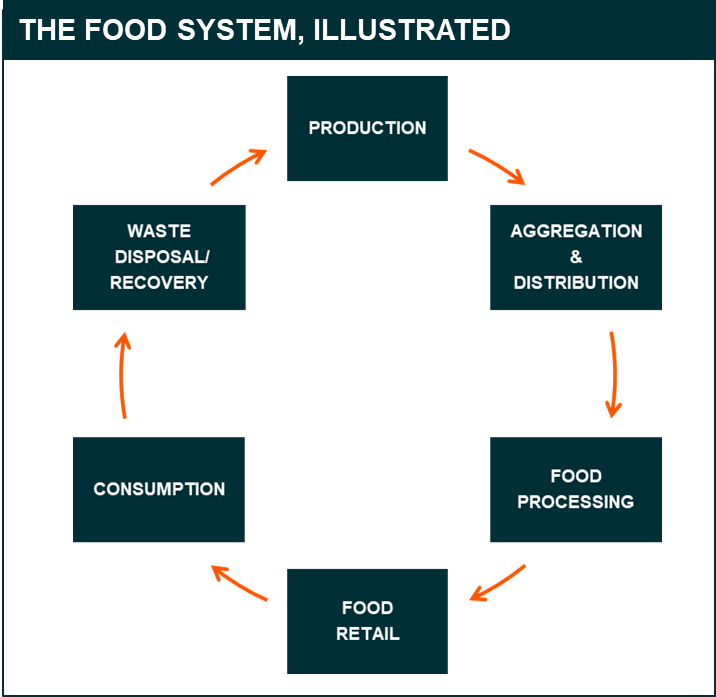
Protein & Dairy Alternatives Go Mainstream (And Get Tastier)
Throughout history, populations consumed protein and dairy alternatives as distinct plant-based food products or as meat and dairy substitutes to conform with religious dietary laws. Coconut and almond milks have long been staple ingredients of various cuisines, while soy-based dishes like tofu date back several thousand years. The 20th century saw the market for these products grow on the back of an expanding vegetarian movement and other dietary restrictions, albeit not at the scale necessary to disrupt existing food systems. Today though, a paradigm shift is already underway.
As we’ve discussed, global populations are facing growing food insecurity in a time when natural resources are diminishing, demand for them is growing, and our planet’s climate is becoming increasingly inhospitable. Ironically, our food systems bear a significant brunt of the blame on all accounts. Food production is extremely resource intensive and meat and dairy products are the primary culprits. Livestock-related production uses 80% of all agricultural land, with pastures occupying almost 85% of this.23 Land used to grow animal feed makes up the remainder of land-use attributed to livestock and around 43% of all agricultural land used to grow food.24 Even further, livestock consumes 36% of the caloric value provided by crops globally.25
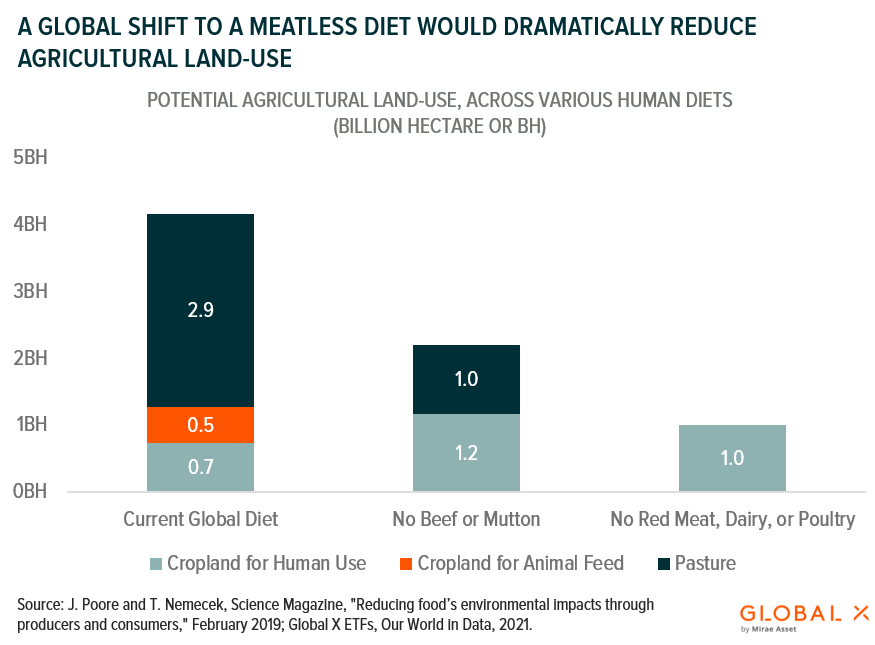
These practices go beyond just pushing resource use to the limit – they lower the limit of what is possible. A recent study found that food systems are responsible for emitting approximately 21-37% of the world’s climate-change causing greenhouse gases (GhG).26 This has significant implications for food production – a separate study found that climate change reduced agricultural productivity by about 21% between 1961 and 2015.27 With food demand expected to increase by as much as 50% by 2050, the current system is clearly unsustainable and must be redrawn.28
Dairy and protein alternatives can serve as a solution. If the entire world switched to a vegan diet, agricultural land use could potentially decrease by about 75%.29 While extreme, this illustrative example introduces an interesting train of logic. Livestock are caloric intermediaries: animals consume plants for calories, and then we also consume animal-products for calories. In the middle of this circle of life are the calories lost through livestock living and growing. Beef food products, for example, only contain 1.9% of calories input through animal feedstock.30 Diary and protein alternatives skip this inefficiency altogether.
Today’s protein and dairy alternatives are seeing greater adoption than those of the past. They are still mainly plant-based – alternative dairy products are primarily made from soy; almonds; coconuts; rice; and more recently, oat extracts, while protein-rich plants like peas, legumes, and also soy, serve as the base for most alternative proteins. But they are better tasting and more diverse than before, bolstered by a greater emphasis on health and sustainable values. A recent International Food Information Council (IFIC) survey found that 53% of U.S. consumers would have their food choices swayed if they had insight into environmental impacts and approximately 80% of U.S. consumers believe the negative environmental impacts of plant-based foods are significantly less than those of meat.31 It also reported that over 40% of consumers believe products described as plant-based are healthier.32
These sentiments, among others, seem to be driving rapid sales growth for plant-based alternatives. The U.S. plant-based food sales totaled $7B in 2020, with year-over-year (YoY) sales growth accelerating by 1.5x to 27%.33 Food products notably led the way: plant-based eggs sales increased 168% YoY to $27M, while sales of plant-based meat grew 45% YoY to $1.4B. Plant-based dairy products also had a strong year. Plant-based milk and other dairy product sales grew 28% and 20%, respectively.34 We expect plant-based food sales will continue on their torrid growth trajectory, especially as sustainable development moves up on the list of global priorities.
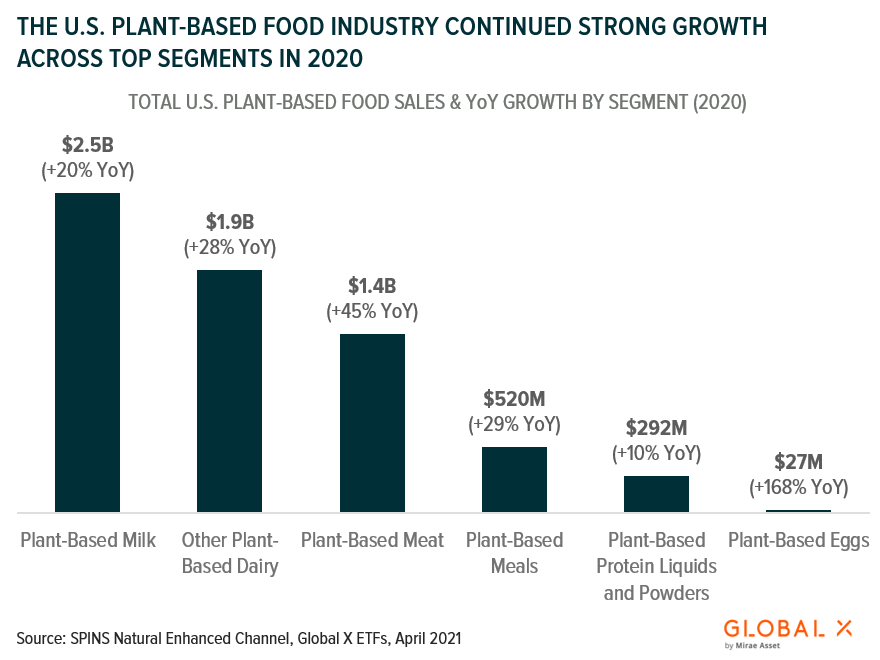
The future alternative food market could potentially have a much deeper offering than just plant-based foods. Alternative foods also include products comprised of non-plant ingredients, though many of these are in their infancy. Protein alternatives made from insects and fungi are probably the furthest along. Many may find the practice irregular, but over 2B people around the world already eat insects for protein.35 Insects require virtually no land and little water, emit very few GhGs, are extremely efficient caloric intermediaries, and produce very little waste.36 There are limited insect alternatives available for consumers as of now, but Barclays estimates that the insect protein market could reach $8B by 2030.37
Lab-grown alternatives made of real meat also show promise but are in an earlier stage. Producing these alternatives involves taking cell cultures from live animals and growing them into consumable meat using a bioreactor.38 This process is currently too expensive to fully implement at scale, but costs declined 99% in recent years.39 Coming off a 2020 that saw lab-grown meat funding increase 510% YoY to $350M, we expect costs will continue to decrease to the point where mass adoption is viable.40 McKinsey & Company projects the market for lab-grown meat could reach $25B by 2030 if all goes according to plan.41
Cost competitiveness and adoption are the primary obstacle to scale for alternative foods. As discussed in our recent CleanTech piece, CleanTech: It’s All About Scale, achieving scale is a chicken-or-the-egg-problem. Alternative food companies need capital to drive their costs down via economies of scale, but also need capital to improve and market their products. Like CleanTech though, alternative foods are positioned to benefit from necessity. We expect scale will arise from the need to mitigate food insecurity, the overstretching of natural resources, and climate change. Though we believe it is still in the early innings for the adoption of alternative foods, we see a long runway for growth. By our estimation, alternative meat accounts for less than 1% of domestic meat sales, and alternative milk only accounts for 13% of domestic milk sales.
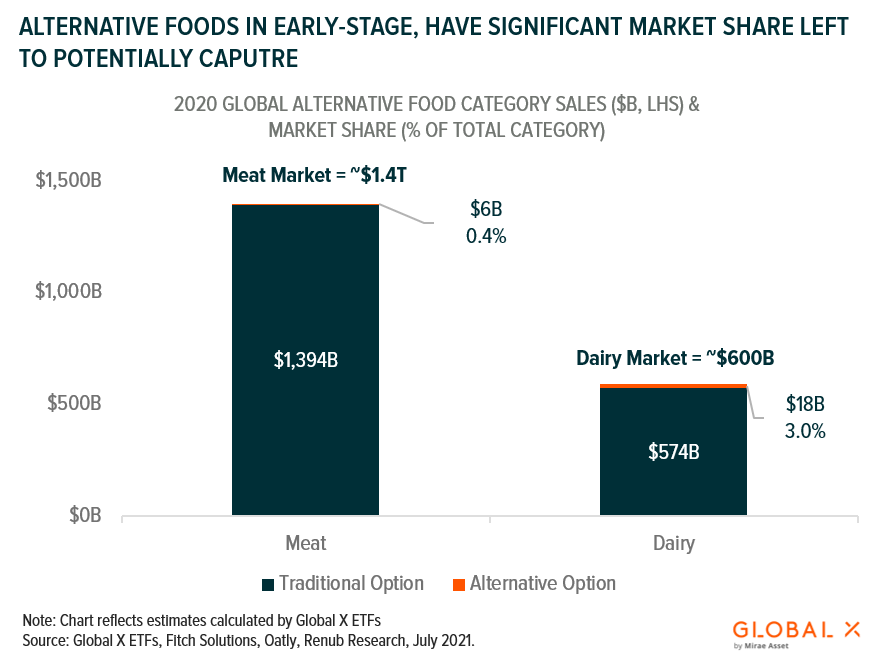
Reducing Food Loss and Waste with Disruptive Technologies
Global food systems are wasteful beyond the inefficiencies and intensive resource-use present in agricultural food production. Almost 1/3 of all food produced goes unconsumed and is either lost or wasted at different stages of the food system.42 Varying food waste reduction technologies can help limit food loss and waste across many of these stages.
Around half of all food loss occurs during distribution, storage, and processing/packaging.43 Food supply chains lose $400B worth of product to improper transportation and storage every year, with food being lost to poor logistics and spoiled due to mismanaged or limited cold chains.44 Disruptive technologies like IoT and blockchain could help reduce these losses. IoT sensors and tags can monitor factors like temperature and spoilage to flag inconsistency and improve logistics through asset tracking. Blockchain can complement tracking efforts by logging tracking and other data in a distributed ledger that introduces full transparency across supply chains (see Introducing the Global X Blockchain ETF). This gives logistics providers accurate real-time insights into their distribution operations. These technologies also allow providers to fine-tune their processes, potentially remediating food loss by identifying where and when food spoils or goes missing. Such improvements could reduce food waste by 3.3M tons annually, saving $8.4B and 528B gallons of water, while also reducing emissions.45
Advanced technologies can help save food downstream as well. Retailers often mark down older food in the hopes of selling perishable products before they expire. Despite this, grocery stores still throw away 43B pounds of food each year.46 IoT and A.I. can mitigate some of this loss by implementing sensors to record data on freshness that A.I. can use to provide more dynamic pricing and reduce overstocking.
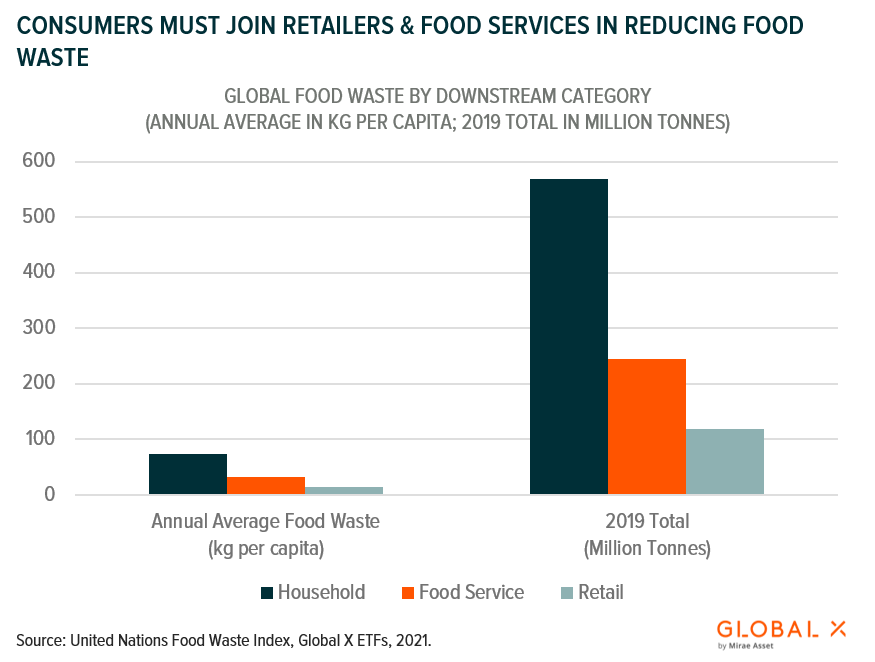
As the global population reaches 10B by 2050, food loss and waste will only increase absent any mitigating actions.47 We are optimistic, though. Reducing waste would have significant upstream benefits, naturally reducing the existing negative externalities presented by food systems and possibly addressing food insecurity. According to an FAO study, a 50% reduction in food loss and waste could reduce the environmental strains presented by agriculture by 6-16%.48 This should be incentive enough for policymakers in the public sector, but the private sector also has skin in the game. The significant savings mentioned above could improve profitability and incentivize food producers, logistics providers, and retailers to reduce their share of food loss and waste.
Investing in AgTech & Food Innovation
Climate change, food insecurity, and water scarcity are among the most critical challenges our world faces today. They are interconnected by natural systems and cycles, but also by their human-impacts and how human activities are perpetuating them. Agriculture and food systems sit at this intersection. While this does mean that many of humanity’s problems are self-induced, it also means that the solutions to these problems can be equally self-directed. AgTech and Food Innovation give us the tools we need to meaningfully address these crises. We believe investment in these areas allows investors to participate in a shift to a more sustainable future, while capitalizing on the potential success of disruptive technologies and the companies offering them.
KROP – Providing Exposure to the AgTech & Food Innovation Value Chains
The Global X AgTech & Food Innovation ETF (KROP) seeks to provide investors with efficient and targeted exposure to various AgTech & Food Innovation sub-themes that we expect to shape the future of agriculture and food systems as the world shifts to more sustainable consumption and production patterns. KROP strives for pure exposure to AgTech & Food Innovation by investing companies that derive at least 50% from activities within these sub-themes, as defined by the underlying index provider.49
Agtech Sub-Themes
- Precision Agriculture: Technologies used to increase crop yields and reduce levels of traditional agricultural inputs (land, water, fertilizer, etc.) to grow crops more profitably/efficiently.
- Agricultural Robotics/Automation: Technologies used to reduce labor and other farming inputs.
- Controlled Environment Agriculture: Technologies and systems that optimize plant and/or fish farming and use controlled environments to reduce the types and/or quantity of inputs required for farming.
- Agricultural Biotechnology: Biological/genetic technologies used to enhance agricultural cultivation and yield.
Food Innovation Sub-Themes
- Protein & Dairy Alternatives: Products containing protein-rich ingredients sourced from plants, insects, fungi, or through tissue culture that replace conventional animal-based protein sources like meat and dairy.
- Food Waste Reduction: Technologies and/or systems designed to reduce food-waste in the supply chain.
Related ETF
KROP: The Global X AgTech & Food Innovation ETF (KROP) seeks to invest in companies advancing innovation and the use of technology in the agriculture and food industries. This includes companies involved in the provision of agricultural technologies (“AgTech”) related to precision agriculture, agricultural robots and automation, controlled environment agriculture (e.g. vertical farming, hydroponics), and agricultural biotechnology, as well as those involved in food innovation activities related to protein/dairy alternatives and food waste reduction.
Click the fund name above to view the fund’s current holdings. Holdings subject to change. Current and future holdings subject to risk.
 Global X Research Team
Global X Research Team